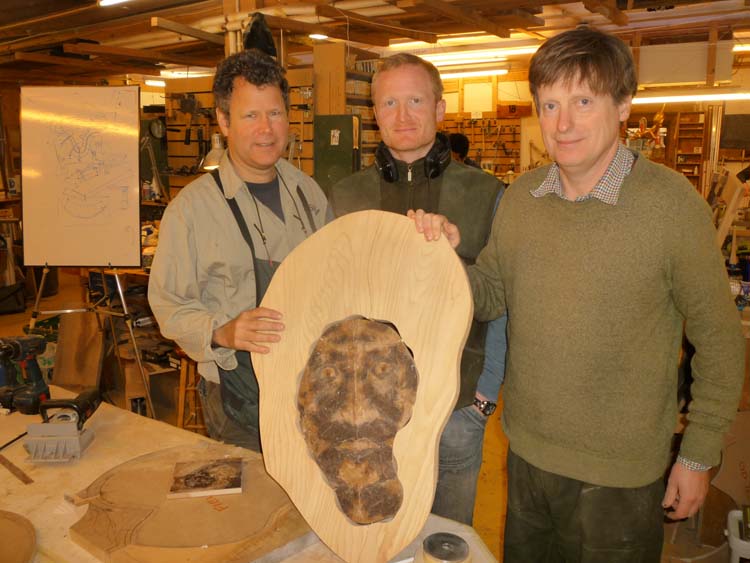Scott Grove, award-winning New York veneering artist, sculptor and woodworker, will soon be delivering another week long veneering course at our furniture school in mid-February 2014. Last year’s was his first ever course at a UK furniture making school. We are delighted to welcome him back. This is the second part of Scott’s blog (read the first blog here).
The Chippendale School’s intensive 30-week furniture design and furniture making course hits a nice median between short programs and a full two- to four-year degree curriculum offer in the States. Dollar for dollar it is a good deal for the serious woodworker and saves a considerable amount of lost earnings time.
The 6000 sq. ft. shop is open 12 hours a day and the students utilize the facilities to maximize their experience. They have an abundance of heavy-duty, well-maintained, solid equipment.
They also have lots of homemade jigs and stations for quick and efficient work for specialized tasks such as dovetailing, spray rooms for finishing, turning, a separate sanding room with downdraft tables, photography, staging and more. When they don’t have an item they improvise with whatever challenge a student comes up with.
“Let’s get on with it!” Anselm would declare, as if nothing could stand in his way. For example, I explained a shooting board for cutting veneer with required ceiling-mounted pressing bars, and before I knew it, the tutors made one.
Anselm is not afraid to purchase whatever a student needs to get a project done. He picked up two deep throat scroll saws just for my marquetry class. He also includes all materials in the tuition, so students don’t inhibit their creative design process with concerns of material cost.
Safety was always stressed and each student was required to own an air-filtered venting helmet for eye, ear and dust protection. I was the one who felt a bit reckless with my paper dust mask, usually sitting around my neck. (I kept telling myself: safety gear has been removed for educational purposes!)
The shop atmosphere is cozy; each student has a bench with a full set of colour-coded tools. They have since expanded the shop, adding another 2800 sq ft, giving each student two benches of their own and allowing for even more ambitious projects.
Each day was action-packed with problem-solving every step of the way. For example, it turns out one can’t buy window screening anywhere in Scotland. (I use fibreglass window screening to help dry out veneer in the flattening conditioning process.) I thought, what… Scotland doesn’t have bugs?
Apparently they don’t use window screens, and we needed to figure out what else to use. This spawned a solution: use a fibreglass mat typically found in boat building. Who knew? We got on with it and kept the ball moving forward.
In concert with pushing the limits, some old-school traditional techniques are also taught such as stained glass, traditional hide gluing, tortoise shell and brasswork (boulle), oyster veneering, brass and mother-of-pearl inlay, and verre eglomisé (reverse glass gilding).
Water gilding is also taught, which is a traditional method used to apply gold leaf that makes a piece look like solid gold. It offers a much higher aesthetic than oil-sized gilding. This was especially interesting to me as this technique is taught only in a few places in the States and I wanted to compare notes. They’ve got it down ‘pat…en’. (Pun intended for gilders).
Evenings I spent discussing woodworking in the UK with Anselm and touring the local sites: castles, coastline, taverns for the best hand drawn ale I’ve ever had, along with some good conversation with the locals, although I couldn’t quite understand a word they were saying. Really, it was right out of a stereotype movie where I’d catch some profanity and the rest sounded like marbles in their mouths. We smiled and laughed a lot and everyone was very friendly.
The food?… did I mention how good the beer was? I was even treated to a massage by a strong-thumbed Mrs Doubtfire-double with all the pleasantries to boot: “Och, my dear, there ya go, there i’ tis, och aye…”
Students stayed in the local picturesque village of Gifford, which was a short bike ride away from the School.
I am anxious to return this season as I’ve been asked to head the entire veneering section. We will expand last year’s program and cover everything from traditional parquetry using a veneering donkey to marquetry, hand cutting to machine cutting, as well as my alternative techniques and compound veneering human forms.
For more information on the Chippendale School of Furniture click on the school menu above.
Hope to see you there in February 2014 or in 2015!
